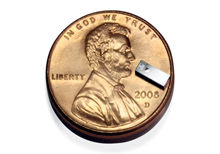A Pacemaker the Size of a Tic Tac
Medtronic, the world’s largest medical-device maker, is using microelectronics and chip manufacturing to shrink pacemakers—implanted devices that regulate the heart’s rhythm. Whereas current pacemakers are about as big as a silver dollar, Medtronic’s device would be smaller than a tic tac. At that size, the device would be small enough to be inserted via catheter, rather than invasive surgery.

The device is still a research instrument, says Stephen Oesterle, Medtronic’s senior vice president for medicine and technology, but it could be on the market in five years.
So far, Medtronic has developed most of the components—a circuit board, an oscillator to generate current, a capacitor to store and rapidly dispense charge, memory to store data, and a telemetry system to wirelessly transfer that data. The company has used chip manufacturing technology to assemble these components onto a wafer. Oesterle estimates that 60 to 70 pacemakers can be made from a single six-inch wafer, which the company creates at its own wafer fabrication plant in Arizona.
“What we don’t have that is fundamental to a pacemaker is a way to power the chip,” says Oesterle. The company is working with startups that make thin-film batteries and other innovative power sources, though Oesterle declined to give further details.
Medtronic’s current-generation device houses all of the components in a small case implanted under the clavicle. Jolts of electricity are delivered to the heart via intercardiac leads. Eliminating the need for leads, which Oesterle calls “invasive and inefficient,” is one of the major motivators in shrinking the device. Impedance between the wires and biological tissue ups the power requirement for the device. And the leads can cause complications if they fail. “You are stuck with either putting in new leads, which takes up space in the vein, or you can pull the leads out, which can risk tearing the heart or blood vessels,” says Emile Georges Daoud, a physician and professor of cardiovascular medicine at Ohio State University.
A system small enough to be placed exactly where the electricity is needed would eliminate these issues. “If you have the pacing element at the area you want to pace, it doesn’t take much power,” says Oesterle. “All you need to do is stimulate one cell in the heart and create a wave of depolarization.”
A smaller device would also be much easier to implant than existing versions. Scientists envision delivering it via the same procedure used in cardiac catheterization, in which a doctor inserts a thin plastic tube into an artery or vein, threading the tube all the way to the heart. The procedure is less invasive than surgical implantation, and more physicians are capable of doing it. “You can almost shoot these things in like bullets,” says Oesterle.
Keep Reading
Most Popular
Large language models can do jaw-dropping things. But nobody knows exactly why.
And that's a problem. Figuring it out is one of the biggest scientific puzzles of our time and a crucial step towards controlling more powerful future models.
The problem with plug-in hybrids? Their drivers.
Plug-in hybrids are often sold as a transition to EVs, but new data from Europe shows we’re still underestimating the emissions they produce.
Google DeepMind’s new generative model makes Super Mario–like games from scratch
Genie learns how to control games by watching hours and hours of video. It could help train next-gen robots too.
How scientists traced a mysterious covid case back to six toilets
When wastewater surveillance turns into a hunt for a single infected individual, the ethics get tricky.
Stay connected
Get the latest updates from
MIT Technology Review
Discover special offers, top stories, upcoming events, and more.